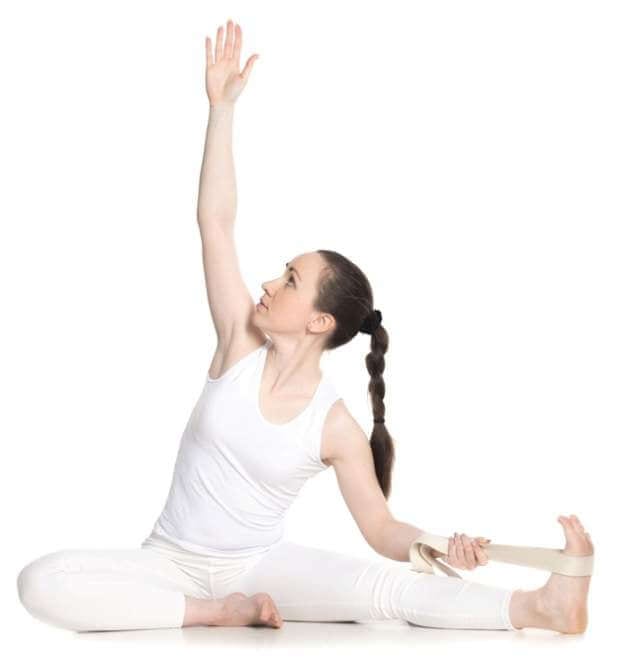If you have been dealing with chronic pain for any length of time, the last thing you want to think about is starting a yoga practice. You might be thinking that if it hurts to move, how can MORE movement be good? Surprisingly, a 2016 study showed that gentle yoga poses and breathing actually reduced the pain levels of people suffering from headaches, rheumatoid arthritis, back pain and fibromyalgia, and other research has shown that yoga can actually reverse the physical effects of chronic pain on the brain. (It’s always a good idea to get clearance from your medical team before beginning any physical activity.)
What types of yoga help with chronic pain?
There are many types of yoga and some are more conducive to the management of chronic pain than others. If you have never practiced yoga before, it’s advisable to start with a gentle, restorative practice such as Yin Yoga. Yin Yoga, originally introduced by Paulie Zink, focuses on seated poses and poses done while lying down. Each pose is held for three to five minutes, which allows the stretch to deepen into the layers of fascia. Yin Yoga focuses on stretching the connective tissue surrounding the joints of the body, with emphasis on the spine, sacrum, pelvis and knees.
Iyengar yoga, pioneered by B. K. S. Iyengar who is credited with bringing yoga to the western world, is a practice that focuses on anatomical alignment and was the first practice to incorporate the use of props such a yoga blocks, straps and blankets to prevent overstretching. Legend has it the Mr. Iyengar took a cinder block from his garden to use as the first yoga block! Iyengar yoga practitioners hold the poses longer than in most yoga classes and there are inverted poses that are strongly encouraged. It is a cautious and mindful type of yoga which can be enormously beneficial for those dealing with chronic pain.

Restorative yoga is a type of yoga practice that focuses as much on the mind as the body. Like Iyengar, it is prop-intensive and the poses are held for longer periods of time. The class begins with a shavasana (corpse pose) in order to truly relax the practitioner and to quiet the body and mind. If you find it difficult to relax into the body and mind at the same time because you are afraid of getting hurt, or because your adrenal system is on red alert, this practice might be a welcome way to integrate mindfulness and calm into your exercise routine. There have been studies that show a connection between stress response and flare-ups of chronic pain in conditions related to autoimmune function, so learning mindfulness-based relaxation can help you manage stress triggers.
If you have a degenerative condition, look for yoga classes specifically designed to support your particular issue. These are mostly taught by yoga therapists and can range from seated-in-chairs yoga to yoga for scoliosis and everything in between! In addition to the therapeutic stretching and movement, these classes also have the added benefit of reminding you that you are not alone in dealing with chronic pain. There are many studies that point to the isolating effect of chronic pain on sufferers, and research shows that community and connection are the best ways to fight the depression that can accompany that isolation.
Most types of yoga incorporate Hatha Yoga poses into their sequences and those classes can provide an alternative if there are no specialized classes available in your area. If the local yoga studio offers Hatha Yoga for Beginners, talk to the instructor and see if modifications can be made for your particular condition. Just keep in mind that a regular class may not provide you with enough targeted modifications/adjustments that are suited for your specific condition and therefore may not be the best choice for your first yoga experience.
Additional Considerations
Another option as you are establishing your yoga practice is to meet with a certified Yoga Therapist to design a custom yoga practice designed specifically for you. Yoga therapists are trained to deal with clients with chronic conditions and usually have knowledge of specific interventions that are useful in helping you manage your condition. These sessions are more expensive than regular yoga classes, but are usually highly effective in establishing your practice faster and with proper alignment and few injuries. The therapist’s sole focus on you and your specific needs, rather than traditional yoga poses and sequences, creates a unique environment for healing.
Whichever type of practice you adopt, remember that your body requires more TLC than a typical practitioner. Wear the supportive braces recommended by your doctor, particularly if your condition affects your joints. One of the great advantages to yoga is that, as a meditative practice, it allows you to tune onto the messages of your body. Don’t be afraid to stop if you are in pain or if you feel like you are pushing beyond what is healthy. After class, it’s advisable to apply ice to calm any inflammation that might have been triggered –think 20 minutes on, 20 minutes off.
Try to find the time for an epsom salt soak to help soothe your sore muscles. When first establishing the yoga habit, consider treating yourself to weekly massages with a body-worker who is experienced in dealing with people with chronic pain issues. Remember to get serious about an inflammatory diet: avoid processed foods, red meat, dairy and simple carbohydrates such as sugar and flour. Instead, fill up on farm-fresh whole foods, lean protein (think wild-caught fish) and load your plate with lots of non-starchy vegetables. And it’s always a good idea to make sure you are drinking enough water; aim for eight glasses per day.
The benefits of starting a yoga practice for people suffering from chronic pain are clear and the increases in strength and flexibility are only part of the picture. Research shows that yoga promotes healing and slows degeneration of chronic conditions. When undertaken mindfully, you can experience greater vitality and a reduction in your pain levels, and increased mental health as you connect with a community of yogis!
References:
https://www.ncbi.nlm.nih.gov/pmc/articles/PMC4878447/
https://www.ncbi.nlm.nih.gov/pmc/articles/PMC2936076/
http://americanpainsociety.org/about-us/press-room/yoga-bushnell
http://www.sciencedirect.com/science/article/pii/S0304395903002021
https://my.clevelandclinic.org/health/transcripts/2748_the-anti-inflammatory-diet-a-way-to-manage-chronic-pain
https://yogainternational.com/article/view/The-Distinction-Between-a-Yoga-Class-and-a-Yoga-Therapy-Session

